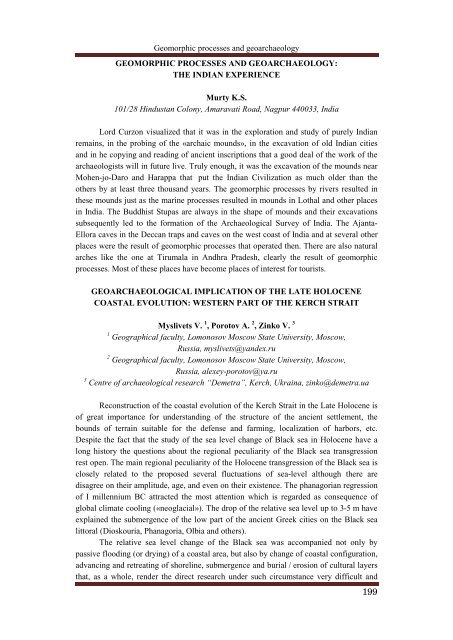extended abstracts - Geomorphic Processes and Geoarchaeology
extended abstracts - Geomorphic Processes and Geoarchaeology
extended abstracts - Geomorphic Processes and Geoarchaeology
Create successful ePaper yourself
Turn your PDF publications into a flip-book with our unique Google optimized e-Paper software.
<strong>Geomorphic</strong> processes <strong>and</strong> geoarchaeology<br />
GEOMORPHIC PROCESSES AND GEOARCHAEOLOGY:<br />
THE INDIAN EXPERIENCE<br />
Murty K.S.<br />
101/28 Hindustan Colony, Amaravati Road, Nagpur 440033, India<br />
Lord Curzon visualized that it was in the exploration <strong>and</strong> study of purely Indian<br />
remains, in the probing of the «archaic mounds», in the excavation of old Indian cities<br />
<strong>and</strong> in he copying <strong>and</strong> reading of ancient inscriptions that a good deal of the work of the<br />
archaeologists will in future live. Truly enough, it was the excavation of the mounds near<br />
Mohen-jo-Daro <strong>and</strong> Harappa that put the Indian Civilization as much older than the<br />
others by at least three thous<strong>and</strong> years. The geomorphic processes by rivers resulted in<br />
these mounds just as the marine processes resulted in mounds in Lothal <strong>and</strong> other places<br />
in India. The Buddhist Stupas are always in the shape of mounds <strong>and</strong> their excavations<br />
subsequently led to the formation of the Archaeological Survey of India. The Ajanta-<br />
Ellora caves in the Deccan traps <strong>and</strong> caves on the west coast of India <strong>and</strong> at several other<br />
places were the result of geomorphic processes that operated then. There are also natural<br />
arches like the one at Tirumala in Andhra Pradesh, clearly the result of geomorphic<br />
processes. Most of these places have become places of interest for tourists.<br />
GEOARCHAEOLOGICAL IMPLICATION OF THE LATE HOLOCENE<br />
COASTAL EVOLUTION: WESTERN PART OF THE KERCH STRAIT<br />
Myslivets V. 1 , Porotov A. 2 , Zinko V. 3<br />
1<br />
Geographical faculty, Lomonosov Moscow State University, Moscow,<br />
Russia, myslivets@y<strong>and</strong>ex.ru<br />
2<br />
Geographical faculty, Lomonosov Moscow State University, Moscow,<br />
Russia, alexey-porotov@ya.ru<br />
3<br />
Centre of archaeological research “Demetra”, Kerch, Ukraina, zinko@demetra.ua<br />
Reconstruction of the coastal evolution of the Kerch Strait in the Late Holocene is<br />
of great importance for underst<strong>and</strong>ing of the structure of the ancient settlement, the<br />
bounds of terrain suitable for the defense <strong>and</strong> farming, localization of harbors, etc.<br />
Despite the fact that the study of the sea level change of Black sea in Holocene have a<br />
long history the questions about the regional peculiarity of the Black sea transgression<br />
rest open. The main regional peculiarity of the Holocene transgression of the Black sea is<br />
closely related to the proposed several fluctuations of sea-level although there are<br />
disagree on their amplitude, age, <strong>and</strong> even on their existence. The phanagorian regression<br />
of I millennium BC attracted the most attention which is regarded as consequence of<br />
global climate cooling («neoglacial»). The drop of the relative sea level up to 3-5 m have<br />
explained the submergence of the low part of the ancient Greek cities on the Black sea<br />
littoral (Dioskouria, Phanagoria, Olbia <strong>and</strong> others).<br />
The relative sea level change of the Black sea was accompanied not only by<br />
passive flooding (or drying) of a coastal area, but also by change of coastal configuration,<br />
advancing <strong>and</strong> retreating of shoreline, submergence <strong>and</strong> burial / erosion of cultural layers<br />
that, as a whole, render the direct research under such circumstance very difficult <strong>and</strong><br />
199


